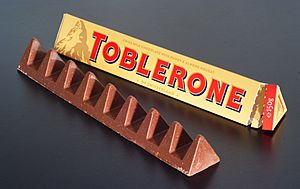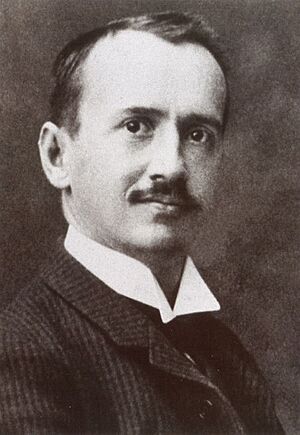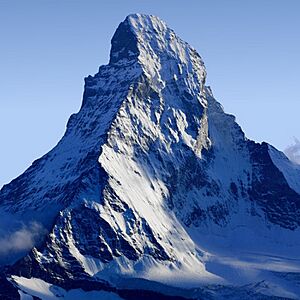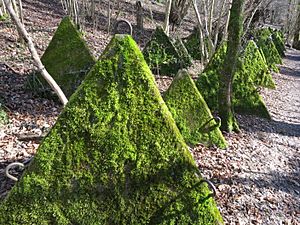Toblerone facts for kids
 |
|
| Type | Chocolate bar |
|---|---|
| Owner | Mondelēz International (U.S.) |
| Country | Switzerland |
| Introduced | 1908 |
| Related brands | List of Kraft brands |
| Previous owners |
|
Toblerone is a famous Swiss chocolate bar. It's owned by a company called Mondelez International. Toblerone is special because of its unique shape. It looks like a series of connected triangles. This shape was inspired by the Matterhorn mountain in Switzerland.
The name "Toblerone" is a mix of two words. "Tobler" comes from Theodor Tobler, who helped create it. "Torrone" is an Italian word for a sweet treat called nougat. Until 2022, most Toblerone was made only in Bern, Switzerland. Now, some smaller amounts are also made in Bratislava, Slovakia.
Contents
History of Toblerone
The Tobler chocolate factory started in 1899 in Bern, Switzerland. It was founded by Emil Baumann and Theodor Tobler. At that time, making chocolate was becoming very popular in Switzerland.
How the Bar Was Created
In 1908, Emil Baumann, Theodor Tobler's cousin, came up with a special recipe. It included milk chocolate mixed with white nougat, almonds, and honey. Theodor Tobler then designed the famous triangular shape and its packaging. The name "Toblerone" combines his last name with the Italian word for nougat, torrone.
Inspiration for the Shape
Many people believe the triangular shape of the Matterhorn mountain in the Swiss Alps inspired Toblerone. However, Theodor's sons said the idea came from a pyramid shape made by dancers. This was at a show Theodor saw called the Folies Bergère.
Even so, a picture of the Matterhorn is on the modern Toblerone packaging. You can also see an outline of a bear on the mountain. The bear is a symbol of Bern, the city where Toblerone was created.
Patent and Early Varieties
Theodor Tobler got a patent for how Toblerone was made in 1909. This means he officially protected his unique chocolate bar. The Toblerone brand was also trademarked that same year. Albert Einstein, who worked at the patent office in Bern, might have even been involved! This made Toblerone the first patented milk chocolate bar.
Over the years, new types of Toblerone were made. A dark chocolate version came out in 1969. A white chocolate version was launched in 1973.
Company Changes Over Time
The Tobler company was independent for many years. In 1970, it joined with another chocolate maker called Suchard. They formed a new company called Interfood. Later, in 1982, they joined with the Jacobs coffee company. This created Jacobs Tobler & Suchard.
In 1990, a big company called Kraft Foods Inc bought most of Jacobs Suchard, including Toblerone. In 2012, Kraft Foods changed its name to Mondelēz International. Mondelez still owns Toblerone today.
Toblerone Sizes and Flavors
Toblerone bars come in many sizes. They range from small ones, just ten centimeters long, to very large ones, almost a meter long! All of them keep the same triangular shape.
Here are some of the different sizes and how many peaks they have:
| Size(g) | Tiny | Mini | 35 g | 50 g | 75 g | 100 g | 150 g | 200 g | 360 g | 750 g | 4.5 kg |
|---|---|---|---|---|---|---|---|---|---|---|---|
| Peaks | 3 | 3 | 8 | 11 | 11 | 12 | 9 | 10 | 11 | 17 | 12 |
Every year, for the Toblerone Schoggifest (Chocolate Festival), a huge bar is made. Its weight matches the number of years Toblerone has existed. For example, the first one in 2008 weighed 100 kilograms!
Since the 1970s, many different flavors of Toblerone have been made:
- Plain chocolate: This comes in a yellow box. (1969)
- Dark chocolate: In a black box.
- White chocolate: In a white box. (1973)
- Milk chocolate Mint Crisp: In a white and green box. (1985)
- Snowtop: These have white chocolate peaks and come in a white or silver box.
- Filled editions: Milk chocolate with a white chocolate center, in a blue box.
- OneByOne: These are individually wrapped triangular pieces.
- Toblerone Pralines: Smaller, single-peak chocolates in a beige box. (1997)
- Fruit & Nut: With a half-purple box. (2007)
- Honeycomb crisp: With a half-white box showing honeycomb pieces. (2009)
- Crunchy Salted Almond: Has honey, almond nougat, and salted caramelized almonds.
- Berner Bär: A 500g milk chocolate bar with a bear's face on it. This is the only Toblerone that isn't triangular!
- Toblerone Tobelle: Thinner Toblerone pieces in a beige box.
- Crispy Coconut: With honey, almond nougat, and coconut.
- Golden Caramel: Caramel with honey and almond nougat.
- Tobler Truffles: A special edition with a box you can personalize. (2022)
Changes to Bar Size in 2016
In 2016, the 400g and 170g Toblerone bars sold in the United Kingdom changed. They had two peaks removed and bigger gaps between the remaining peaks. This made the bars lighter, reducing their weight by about 10%. The goal was to lower the cost of making them while keeping the same package size and price.
Many people were not happy about this change. Some even called for "government action" in Scotland! In 2018, the bar went back to its original shape. The 170g/150g bar was replaced with a 200g bar.
Where Toblerone is Made
In the past, Toblerone was made in other places. These included Bedford in England and Dundee in Scotland until 1969.
The company that owns Toblerone, Mondelez, started making some Toblerone in Bratislava, Slovakia in late 2023. Because of Swiss rules, if a product is not made entirely in Switzerland, it cannot say "Swiss" on the packaging. It also can't show images typical of Switzerland, like the Matterhorn. So, the bars made in Slovakia are labeled "created in Switzerland." The Matterhorn image on their packaging was replaced with a new, simpler mountain logo.
In April 2025, Mondelez International announced a big investment in its Toblerone factory in Bern, Switzerland. This factory is Toblerone's main production center. About 90% of all Toblerone sold worldwide is made there. To show its Swiss heritage, Toblerone packaging for chocolates made in Bern now features the famous Swiss flag. This highlights the product's true origin.
The main ingredients in a classic Toblerone bar include sugar, milk powder, cocoa butter, cocoa mass, honey, milk fat, almonds, and egg white.
Similar Chocolate Products
Toblerone's unique recipe quickly inspired other chocolate makers. By 1920, another Swiss company, Cailler, launched a similar chocolate called Chocmel. Frey, another Swiss company, also makes a comparable chocolate called Mahony.
In 2017, after Toblerone reduced its size, a UK store chain called Poundland launched its own version. It was called "Twin Peaks" and was actually larger than the changed Toblerone bar.
Toblerone's Cultural Impact
The unique triangular shape of the Toblerone bar has influenced many things.
Toblerone Line
During World War II, Switzerland built a line of anti-tank defenses. These were pyramid-shaped concrete blocks. Because they looked like Toblerone pieces, they became known as the "Toblerone line".
In Movies and TV
The inside of the Toblerone factory in Switzerland was used for filming the opening scene of the movie Willy Wonka & the Chocolate Factory. Most of the movie, however, was filmed in West Germany.
A funny character from UK comedy, Alan Partridge, often struggled with eating too many Toblerones. This became a running joke in his TV show.
Political Story
In 1995, a Swedish politician named Mona Sahlin faced a problem. She had used her government credit card for some personal shopping. Among the items she bought were two Toblerone bars. Some journalists tried to make the issue seem small by calling it the "Toblerone affair." Even so, Mona Sahlin had to step down from being a candidate for Prime Minister. She later returned to politics in 1998.
Buildings and Jokes
A group of triangular student homes at the University of Manchester in England are also known as "the Toblerones." They were built around 1975.
The largest size of Toblerone is often used as a funny recurring joke in the 2017 Netflix series Neo Yokio.
Connection to Air Travel
Toblerone has long been linked to air travel and duty-free stores at airports. Many people remember buying Toblerone when they traveled. It felt special because it was often only found at airports.
Mondelez, the company that owns Toblerone, has used this idea in its marketing. They've had campaigns like "Sense of Place" with special travel-themed packaging. In 2022, their #TravelisBack campaign aimed at younger travelers. In 2024, Toblerone even had a "Win a Diamond" contest, connecting the bar's shape to diamonds.
Images for kids
-
Advertising in the 1960s included a model Volkswagen Type 2 by Corgi Toys, featuring Toblerone designs.
See also
 In Spanish: Toblerone para niños
In Spanish: Toblerone para niños








